 |
Blair Witch 2016 - Nearly 17 years after the cult original, the story of the Blair Witch continues in a direct sequel. |
 |
| The 1999 original movie which kick started a pop culture phenomena. |
In 1999 a small, indie horror film began to stir mainstream attention as its reputation grew, and indeed, the urban legend that seemed to grow in tandem with it. Titled "The Blair Witch Project", the film chronicled the self-documented work of three Maryland college students - Michael, Joshua and the determined Heather - to produce a documentary on the persistence of a local legend of Montgomery county, particularly the Blair Witch and the ostensible legacy of her curse upon the adjacent woods of the Black Hills. Beginning with the deathly banishment of one Elly Kedward from the township of Blair in 1785, as punishment for witchcraft, the surrounding region had been colored by strange, mysterious and sometimes gruesome events of seeming supernatural inspiration. It was upon this tradition that the three resolved to research the essence of the strange legends of the locality - a seemingly innocent and at first care free adventure which, as the group chronicles on their camera, begins to be marred by strange occurrences, and more so as they become lost in the Black Hills of legend. Apparently harassed and demented by unseen, malign forces which attack both body and mind, the group begins to fragment as they inadvertently begin to encounter terrifyingly real evidence to the existence of Elly Kedward - the Blair Witch of legend. Losing one of their number, and drawn within the decayed rooms of a mysterious woodland house, the now alone Heather offers her last testament to the camera before the device falls away - her fate and that of the others unknown.
The movie a growing success, it's reputation was compounded by mingling fact with fiction as sources intentionally sought to depict what was seen on screen as fact: suggesting that the three students were truly missing after the events so recorded by their mysteriously unearthed camera, and more with the release of a number of fictitious "mockumentaries" in which local people, academic and other authorities were consulted on the credibility of the haunting and the ostensible curse laid upon the region by the banished witch of legend. It was within these - particularly the central work of "Curse of the Blair Witch" - which sought to furnish and texture the historical context and the resultant legacy of strange happenings, tragedies and blood letting which had marred the more obscure corners of local history in western Maryland.
As the haunting reputation and strange nature of the film spread, it fell to many to actively query if such things were real - the once pop culture phenomena translating to numerous remarkable incidents in which Burkittsville - the latter day Maryland township where the fictitious Blair sat - was sporadically overrun with tourists, the curious and others increasingly invested in the latter day urban legend of the Blair Witch. More so, it came to be the mother of the lead actress was even sent condolences regarding her daughter's "disappearance" and others actively pursuing the idea if there was any truth, even tangentially, in what they had come to know of, or had seen.
As the haunting reputation and strange nature of the film spread, it fell to many to actively query if such things were real - the once pop culture phenomena translating to numerous remarkable incidents in which Burkittsville - the latter day Maryland township where the fictitious Blair sat - was sporadically overrun with tourists, the curious and others increasingly invested in the latter day urban legend of the Blair Witch. More so, it came to be the mother of the lead actress was even sent condolences regarding her daughter's "disappearance" and others actively pursuing the idea if there was any truth, even tangentially, in what they had come to know of, or had seen.
In all, this phenomena was the product of a well considered, and even audacious, campaign by the creator's of the movie to compel a unique, singular vision of a horror narrative: this attempt cresting in the mediated reality of the "found footage" movie, the unreality of what was known or conjectured and the myriad questions that arose afterwards. These elements all realized with a frighteningly vivid energy in TBWP, the separate methods which were invested in this experience were pioneering for their time, and realized a new plateau of media narrative for a 21st century viewer.
Though it was not the first of its kind in the genre, the cinematic concept of the "found footage" movie was popularized - and some say even perfected - in this singular project: the fragmented, sometimes haggard footage which bounces between the increasingly fraught characters building both an intimate experience and a tangled opinion of an outer world that is dark and eminently dangerous for the trio. More so, the pathos which is cultivated through the medium is crucial in delivering both a seemingly authentic experience, but also an ambiguity in what is seen, being seen and believed with the camera.
Though it was not the first of its kind in the genre, the cinematic concept of the "found footage" movie was popularized - and some say even perfected - in this singular project: the fragmented, sometimes haggard footage which bounces between the increasingly fraught characters building both an intimate experience and a tangled opinion of an outer world that is dark and eminently dangerous for the trio. More so, the pathos which is cultivated through the medium is crucial in delivering both a seemingly authentic experience, but also an ambiguity in what is seen, being seen and believed with the camera.
Concordantly, the movie's innovations - so lasting and singular as it came to be - worked to prefigure norms of online sub-culture, before even the popular vocabulary existed to conceptualize this organic behavior online. The movie's cinematic contribution indelible, it would remain more so that the movie and its associated artifacts had diffused into pop culture with a remarkable energy; cultivating not simply a sensibility but an institution that was particularly strong in voice in those early years following the movies release in 1999. It's here that we find a rise of new and often interesting media which sought - sometimes in part or directly - to explore and further texture the urban lore of the movie's story
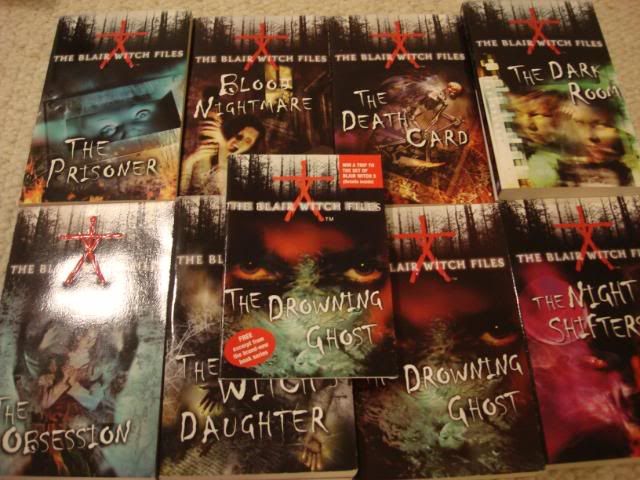 |
The Blair Witch Files novel series (2000-2001) |
The popularity of the narrative growing quickly, a number of notable divergences produced several interesting insights into the cultural universe - though not always dealing directly with the events of TBWP - but to further color and contour an already compellingly dark narrative. In terms of popular literature, a series of short novels were commissioned between 2000 and 2001 set to localize the Blair Witch haunting in a series of tangential encounters. Known as "The Blair Witch Files", the stories focused upon a particular cousin of the vanished Heather Donahue - Cade Merill - who's attempts to unravel the mystery of her relative's disappearance propels a number of encounters with the witch's ghostly, often frightening legacy. The book's tapping the then growing potential of young adult literature to cultivate franchises - as with the Harry Potter books successful transition to the big screen - it followed that other, more singular attempts would be made to narrate the strange, dark and often more gruesome elements of the lore, as with the 2004 novel "BW: Graveyard Shift" and 2000's "The Secret Confession of Rustin Parr".
 |
| The Novel "BW: The Secret Confession of Rustin Parr" by D.A. Stern, 2000 |
A late and somewhat more contemporary figure in the dark, often gruesome mythos of the haunted Black Hills, Parr is the figure central to the massacre of the "Burkittsville Seven" - the group of youngsters he abducted from the town in 1940, while making an eighth bare witness to his murders. Though ultimately surrendering to authorities, tried and then hanged for his appalling crimes, it remained to the condemned that he believed himself influenced by the power of a dark, ghostly presence in the form of a black clad old woman, and her voice, which instructed him in the specifics of his crimes. Of course, Parr's assertions are not greeted warmly, though it remains that the subject of what truly transpired over the last year of the hermit's life - when he came under the witch's influence - is the subject of some curiosity, and it is within the pages of this book that this theme is further explored. Given to a priest on the eve of his execution, and in secret, Parr relates to one Dominick Cazale the strange story of how and why he came to kill, and what may have impelled him to do so - perhaps the true culprit of the killings, while Parr was but a puppet of other worldly forces about his forest home in the Black Hills.
The continuity a particularly fecund subject for the resurgence and increasing mainstream appeal of comic book culture, the franchise found attention in a number of short, but interesting, projects concurrent with the times. At first specific to a small anthology baring three stories, tapping the myth of the Blair Witch, a somewhat longer running series was produced titled "The Blair Witch Chronicles"
 |
| The Blair Witch Chronicles (1-4) series (2000-2001) An anthology series exploring and illustrating varying chapters of the Blair Witch mythos. |
Perhaps inevitably, there would come two of the more widely known - though now somewhat clouded - contributions to the institution of the Blair Witch in a computer game series and a first sequel movie. The games would go on to form a loose trilogy - exploring though also tempering the original narrative and cultivating sometimes wholly original or inspired interpretations of the historical episodes which make up the legend. Made in episodic installments, volume one dealt with the Rustin Parr murders as a case for a government agency, and focused upon the strange adventures of two such agents (not unlike the X-Files franchise, also very popular at the time) as they struggle against the haunting in Burkittsville, and around the young Kyle Brody too. The second volume would step further back in time in finding a wounded Union army officer shunted forward in time by twenty years to the Coffin Rock incident of 1886.
Far removed from the civil war and bewildered, he becomes entangled in the strange goings on which culminate in the gruesome massacre atop Coffin Rock - touching upon the life of Robin Weaver and other specters which haunt the surrounding Black Hills. The third and last volume focuses upon - albeit with a very dilated style - the genesis of the Blair Witch legends and the banishment of Elly Kedward from the township of Blair in 1785. Taking the role of a haggard witch hunter, the player discerns that there is more at play in the strange rites and circumstances of the township and its woods; more so, leading them into conflict with the undead, demons and other spirits. The game's sought to cultivate an ambiance of their own and were fairly piquant in places, though a mixture of narrative dilation, technical issues and other contextual problems did little to endear them to the wider public, more interested in the essence of the legends than in spin offs or often radical departures from what had become the norm of the continuity.
 |
| The "first" sequel to the indie original - the more mainstream horror "Book of Shadows: Blair Witch 2" in 2000. |
Considering the full scope of the then growing franchise's popularity and culture purchase on the public imagination, it would be perhaps inevitable that mainstream Hollywood would seek to further capitalize on the course of events, and it was soon found that a more mainstream sequel was in the running to be made. Eventually emerging as "Book of Shadows: Blair Witch 2", the movie was a much more conventional run which sought to extend the story told in the indie original, but cultivating the remarkable phenomena of its popularity to create something singular.
What is found in the 2000 movie is a western Maryland very much in the grip of BW fever as all shapes and shades of person arrive in the locality - curious, intrigued and vaguely compelled by the growing urban legend of the movie seen. A cluster of strangers meeting with a tour guide to explore a portion of the wooded lands about the Black Hills - a seemingly profitable business since the surge in media attention - what becomes of the group at night is forgotten as daybreak finds them disheveled, their belongings in disarray and with only their video camera as evidence of what has transpired between them.
Retreating to the guide's apartment, close to the forest threshold, the night that follows is alight with haunting's, terrors and apparitions as the Blair Witch's power works to fracture the group before death follows later. The movie concludes with a dark, mysterious ending for the survivors, now in police custody: it implied that what finally transpired was the machinations of the witch, in the end. Though pressed with its own aesthetic and attempt to cultivate a new, more conventional approach to the mythos, the movie lacked in key areas which had so made the original unique; seeming to work the lore into a sometimes fragmented and soon too conventional horror film which lends itself to little of the Blair Witch narrative, in the end. Considered to be something of a formulaic cash in, at the time, the movie remains to evoke ambiguity and criticism in the fan base, and elsewhere, seen as perhaps the weakest in the franchise's segments.
What is found in the 2000 movie is a western Maryland very much in the grip of BW fever as all shapes and shades of person arrive in the locality - curious, intrigued and vaguely compelled by the growing urban legend of the movie seen. A cluster of strangers meeting with a tour guide to explore a portion of the wooded lands about the Black Hills - a seemingly profitable business since the surge in media attention - what becomes of the group at night is forgotten as daybreak finds them disheveled, their belongings in disarray and with only their video camera as evidence of what has transpired between them.
Retreating to the guide's apartment, close to the forest threshold, the night that follows is alight with haunting's, terrors and apparitions as the Blair Witch's power works to fracture the group before death follows later. The movie concludes with a dark, mysterious ending for the survivors, now in police custody: it implied that what finally transpired was the machinations of the witch, in the end. Though pressed with its own aesthetic and attempt to cultivate a new, more conventional approach to the mythos, the movie lacked in key areas which had so made the original unique; seeming to work the lore into a sometimes fragmented and soon too conventional horror film which lends itself to little of the Blair Witch narrative, in the end. Considered to be something of a formulaic cash in, at the time, the movie remains to evoke ambiguity and criticism in the fan base, and elsewhere, seen as perhaps the weakest in the franchise's segments.
With the institution of the franchise fairly static since the early-mid 2000's, this stasis has finally been broken with news in 2013 of a new Blair Witch installment and the final, surprising, revelation that a certain movie in production - called "The Woods" - was actually a truer, direct sequel to the 1999 original as "Blair Witch" in 2016.
With the cultural legacy and its numerous forms or iterations considered, as far as I know them, it would be perhaps of interest to a fan looking to catch up on the lore or another curious party to reflect the continuity of the legend so often evoked in the numerous stories and dramas above. In turn, it's to this end that I think it of interest to peruse a brief history of the Blair Witch - her person, events and legacy - from her beginnings to latest manifestation in the movie which will premier very soon. This can be found below, drawing from her origins to the misadventure of Heather Donahue's brother in the present day.
With the cultural legacy and its numerous forms or iterations considered, as far as I know them, it would be perhaps of interest to a fan looking to catch up on the lore or another curious party to reflect the continuity of the legend so often evoked in the numerous stories and dramas above. In turn, it's to this end that I think it of interest to peruse a brief history of the Blair Witch - her person, events and legacy - from her beginnings to latest manifestation in the movie which will premier very soon. This can be found below, drawing from her origins to the misadventure of Heather Donahue's brother in the present day.
A History of the Blair Witch
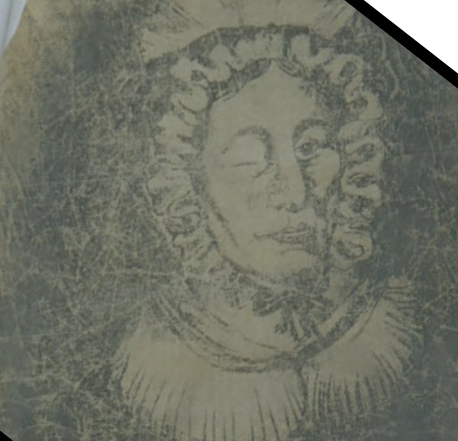 |
Eilis "Elly" Kedward - "The Blair Witch" - 1739(?) to 1785(?)From a sketch of the subject, possibly 18th century copy |
The kernel of the legacy so remarkably and darkly wrought begins with the life, and death, of a woman named Eilis "Elly" Kedward. Living an unsung, but reputedly hard, life in Ireland, she gathered her few possessions and boarded a ship named "The Reliant", intent on a new life in the New World of the Americas in 1769. Arriving in the still colonial province of Maryland, Elly went west and settled in the rural township of Blair; the village far west of Baltimore and originally founded in the shadow of the nearby Black Hills forests to preserve the routes to the eastern seaboard. Despite being quite removed from her new neighbors in both manner and custom - being of Irish Catholic stock compared to her Protestant peers - Elly seems to have lived a peaceful, or at least unremarked, life in the proceeding years: living out the upheaval of the revolutionary war to find herself among the first Americans of the State of Maryland.
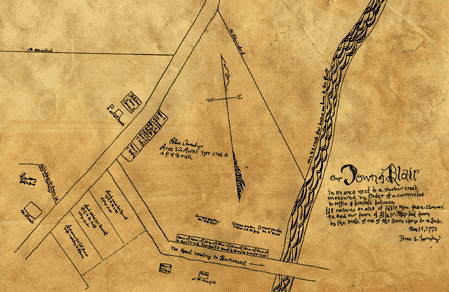 |
| The Township of Blair (3,000 acres) founded 1771, and the nearby creek - a map from the period. |
Unfortunately, the years that followed would find her less so, come the particularly severe winter of 1785. The seeds of the original cause finding a few variations, over the years, it seems that - for reasons ultimately unknown - several children openly accused Elly of persuading them into her home to draw blood from them. The affront growing into a wild sensation, drawing upon earlier ill regard and suspicion, the elderly woman was arrested and imprisoned. Subject to trial, she was brutalized in search of confession for Witchcraft, while others proffered their own incidental evidence of her guilt. Eventually found guilty by her peers, the sentence customary to the time and region was handed down and Elly was subject to a very particular kind of banishment from Blair.
 |
| Elly Kedward is bound to a tree in woods where she would die - a contemporary sketch of her final days |
Tied and blindfolded, she was loaded onto a cart which was drawn on a long path into the nearby woods of the Black Hills by the escorting party of townsfolk. Once suitably deep in the woods - all the more removed as a freezing, barren wilderness in such a winter - she was tied again to a tree while the party returned to the distant village: the tacit understanding being that the elderly woman would soon succumb to exposure. And yet, strangely, it proved not so simple a conclusion. Seemingly, over succeeding nights, parties of the town's children - principally boys - took to venturing out into the forest to see the brutalized, condemned woman. It was during these ventures that some in the party took to torturing her further - pressing their hands to her bloody, wounded body - and even setting their dogs to bite at her flesh. Succeeding nights of this, remarkably, found the woman still alive and, ultimately, it was decided to conclude the affair altogether. On this final occasion, Elly was released only to be hung from a branch of the same tree.
Her life ended, the party would return to the town and life would continue as it could, until the winter of the following year in 1786. It was the advent of this season which would see the town and surrounding region touched by a strange and malign power - of which only fragmentary documentation remains - as those same children who accused Elly one year before disappeared, as did so many others too. Amid a surge of withering and dark encounters with supernatural forces, seemingly brought to bare by Elly's vengeful form, the township of Blair is finally abandoned. Removing themselves to nearby towns, the former residents speak little of their former home, and only do so sparingly some years later as the village of Blair, and the strange deeds surrounding it, fades into lore.
Though the accounts and bedeviled history of the incident would fade, it would be seemingly preserved in a singular volume of the period, the obscure "The Blair Witch Cult", apparently discovered in 1809. A fragmented, obscure and often lurid account of the banishment and subsequent incidents that followed, the account's existence and nature has summoned divided opinion as to its credence: some believing it a fearsome testimony of the Blair Witch's vengeance, while others consider it a fanciful hoax, playing upon the older lore of region. Though the tales of the Blair Witch lingered, the township of name would not return to being until a chance discovery by businessmen intent on forging a railway through the region discovered a forgotten forest road, leading to the decayed, weathered remains of a small township - the land about unkempt while the empty homes had been boarded shut long before their discovery, now in 1822.
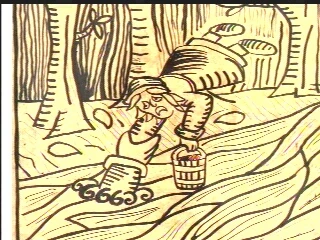 |
| The Tappy Creek Incident - a sketch of Eileen Treacle being pulled under by a ghostly hand. |
The half forgotten village of Blair found anew, the site gave way to the new town of Burkittsville in 1824 as new residents and farmers settled in the neighborhood. It would be little later, in 1825, that the legacy of the region would stir anew as well, and with strange, tragic consequences for the new community - as yet unfamiliar with the lingering force about them. In the spring of that year, a party of local residents intended to mark the occasion of the first harvest with a picnic near the Tappy East Creek. It was during these innocent festivities that a young girl by the name of Eileen Treacle wandered away from the main party and, lingering by the water, was seen by eleven others to be suddenly seized by a ghostly white hand which then pulled her under the shallow waters. The shock that followed gave way to alarm and bewilderment as those searching from the girl found the water to be merely a few feet deep, and more so, no evidence of the presumably drowned body was ever recovered.
Still, it would be that the waters would soon turn oily and flow with strange, roughly fashioned totems: the event lasting for almost two weeks and noted as rendering the creek seemingly toxic to use. The supernatural quality to the disappearance, and presumed death, would mark a particularly sinister junction in the history of the new town, and coloring its culture until an even greater, disturbing event in the Coffin Rock incident of 1886, in which the Blair Witch was believed to have acted again. In this particular year, another young girl named Robin Weaver was walking in the nearby forest when she encountered the strange, but not particularly fearsome, sight of an older woman floating above the ground. Taking the girl's hand, she led her to an old house deeper amid the trees and down to the basement where she instructed that the girl remain until she returned. Hours passing, Robin's fright shook her to action and she fled through a nearby window, and back to the town. Still, in the intervening hours, word of the girl's disappearance had spread and a search party has been hastily assembled to find her. Hours passing, Robin did indeed return, though the party who had gone in search of her did not. Time passing, another party was arranged and soon set out to locate their companions - a gruesome discovery near the waters of the creek.
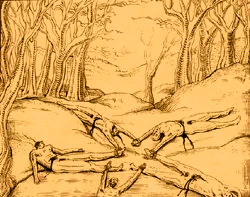 |
| The scene at Coffin Rock - the massacre so described by the second search party upon discovery |
On a small promontory overlooking the waters below - known portentously as "Coffin Rock" by local trappers - the second search party discovered a singular and horrifying spectacle. Their predecessors were found dead: bound together and arrayed with a seemingly ceremonial intent before their mutilation and death - each man baring evidence of living struggle during the incident which would see arcane symbols carved upon their limbs and faces, before final disembowelment. Stunned and exhausted, the search party would report this shocking scene to local authorities in detail, but it would amaze and frighten those same authorities to find the same place empty of bodies, when they arrived: vultures noticed nearby and lingering scents, though the remains had vanished - seemingly spirited away in just a matter of hours. The event casting a long shadow - albeit inexplicable, to some - it would remain that Robin Weaver would live the following years of her life in the township, before moving at the age of 50. She spoke little of the astonishing event since then, though would sparingly relate that she couldn't forget the face of the strange woman she encountered in the woods, so long before, or her smile.
As disturbing and horrible as the incident was, the relative mystery and staggered nature of events around Coffin Rock somewhat clouded overtime, though what would transpire later in the following century would bring the story of the search party into a horrid new relief - for those few cognizant of its details. In 1940, a local hermit by the name of Rustin Parr appeared in Burkittsville, declaring himself to be "finally finished" - a strange intonation, given his reclusive nature and the recent disappearance of eight children, in the locality. Surrendering himself to Police, his words were investigated and his woodland home searched. In the basement was a grisly testimony to his alluded labors: the remains of seven children who had disappeared in the local neighborhood, all of whom had been mutilated before disembowelment - arcane symbols carved into their faces and limbs as they struggled in his hands. This was further testified to by the sole survivor of the abductions and killings in the young Kyle Brody - the boy made to stand, facing one particular corner of the basement, while Rustin successively murdered the other seven, sometimes asking his captive if he heard "the voice" as keenly as he himself did.
 |
| Rustin Parr appears before a court - though he apologizes for his crimes, he indicts the ghost of an old woman as the driving force. |
The voice - and indeed, the influence Rustin pressed - was that of what he described as an "old woman ghost" and the force which had impelled him to abduct and murder the seven children, while making Kyle stand in the position forced upon him. The nature and image unmistakable to local residents as the Blair Witch, Rustin would go on to elaborate that his encounters with her had been over a year before his actions: brief and mysterious, before she started to exact upon him her influence. Appearing as a cloaked and hooded figure in black about the forest, she would appear closer to his home; these appearances concurrent with horrific, chanting voices Rustin heard at night, along with other strange phenomena. Her voice heard to him at night, it was soon heard during the day and the identity of the voice ordered him, in November of 1940, to travel down to the town and abduct children he found there - after which they would be killed, as they were. After the final killing, the entity appeared as the singular apparition of the black clad old woman and, with the same voice, informed him his work was done and that she would leave him if he went down to town and confessed what he had done.
The horrid account known aloud in the trial that followed, Rustin's assertions that he had been impelled to his actions by the ghost - implied to be the legendary witch - was met with cold disdain. Found guilty of his crimes, he was hanged thereafter in November of 1941. Kyle Brody would go on to live a very troubled life in the decades after his experience. A life punctuated by anti-social behavior and encounters with law enforcement, an aimless life come to more focus when he was committed at a psychiatric facility in his native Maryland, for the second time. Unfortunately, it is here, in 1971, that Kyle Brody commits suicide by gashing his wrists with a stolen utensil.
 |
| Heather and Michael discover a blood soaked rag, bearing human viscera, teeth and hair - from the vanished Josuha - as they are harassed by malign forces |
The legacy of recent encounters with the reputed Blair Witch lingering only in a few, the reach of the legend inspired a college student of the early 1990's to propose a documentary at Montgomery College - the intended film meant to provide a wider historical narrative regarding the dark history of the region, and the elements at play in the account. To this end, Heather and two fellow students, Joshua and Michael, agree to contribute to the project, providing technical assistance.
Heather and her friends embark on their project in spring of 1994, making preparations for their final filming with some light supplies and collecting interviews from Burkittsville residents before driving further into the Black Hills and making progress into the nearby woods. The trio's project making a fairly ordinary start, strange and soon supernatural phenomena begin to build as they find themselves not only lost, but harassed by something malign. One of their number disappearing into the night, those remaining happen upon an old, derelict house - seemingly to be the home of Rustin Parr - though it's soon noted that would be impossible as that same place was burnt down after his conviction. It is here, finally alone, that Heather makes her last terrified and tearful words for the camera before the device falls to the ground and the screen cuts off.
 |
| Heather's last moments of footage before she vanishes |
The disappearance of the college students growing into a wide concern, police and local authorities mount a search over ten days in the Black Hills - their exploration recovering only the group's car, found as it was on a road they had taken from their earlier visit to Burkittsville. The group seeming to have vanished, a strange and wholly unexpected lead arises when researchers from the University of Maryland are unearthing the remains of a colonial era house in the Black Hills when a remarkable discovery is made. Reaching far into the depths of the house's foundations, the group finds a duffel bag beneath many layers of ancient, undisturbed soil, enclosed by a corner of colonial era stonework. The paradox self evident as to how an object of modern manufacture came to be found in the soil beneath what had been an 18th century house and in such a specific place - seemingly undisturbed for centuries - bewildered the researchers, but yielded an array of portable media, as with the tapes specifically accrued from the doomed group's filming project. The contents of these tapes would go on to be analysed and then compiled into a feature presentation, ostensibly to help locate the missing students - though the trio were never found, as attested.
So many years removed from the original, fateful incident the legacy of those days carries on - borne about and further by the frightful history and supernatural aura of what brought Heather and her friends to investigate the Blair Witch, and what may have ultimately done away with them. To this end, it stands that James, the younger brother, of the long vanished Heather Donahue, discovers footage on YouTube, ostensibly uploaded by an individual who discovers a tape in the Black Hills - the footage a tumult of images culminating in a brief glimpse of what seems to be Heather. Hoping this may be her, and against other's reservations, he sets off with friends to discover the truth, amid the woods of the Black Hills...
This new installment in the reinvigorated franchise will make its American debut on the 16th of September, 2016. Considering what might become of it, I will consider a review and how what unfolds may resonate with the wider mythos, so touched upon above.
Clark Caledon.
Clark Caledon.

No comments:
Post a Comment